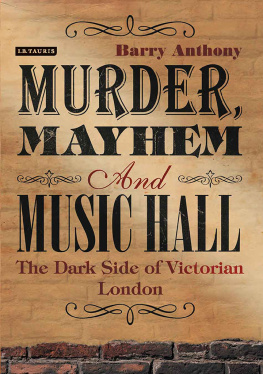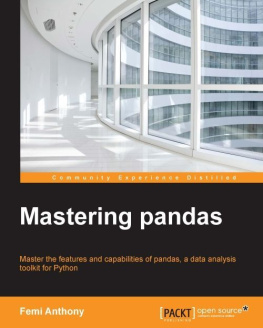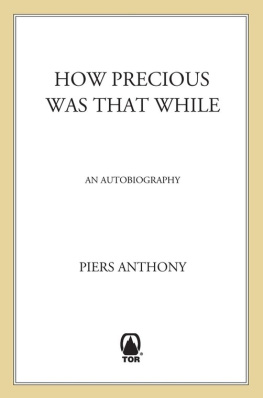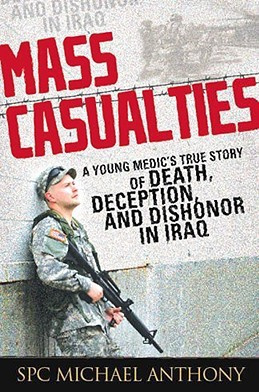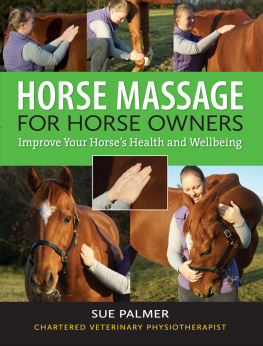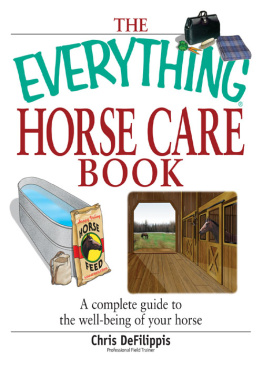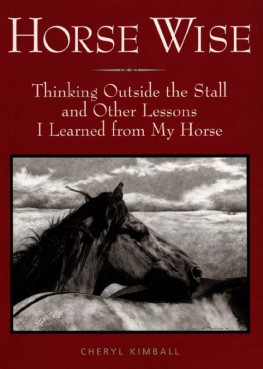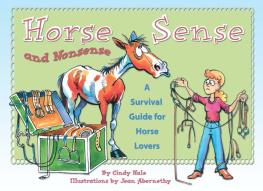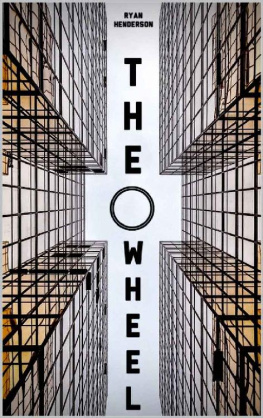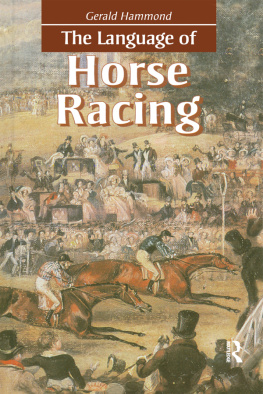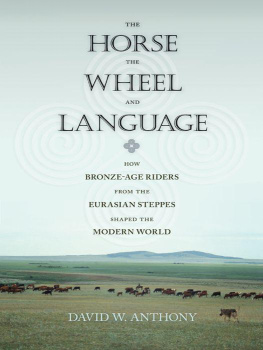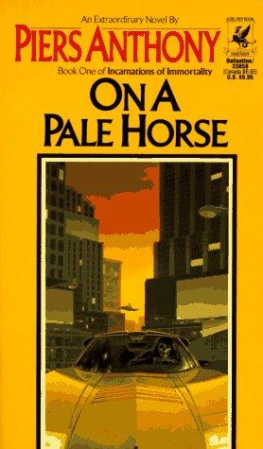Anthony - The Horse, the Wheel, and Language
Here you can read online Anthony - The Horse, the Wheel, and Language full text of the book (entire story) in english for free. Download pdf and epub, get meaning, cover and reviews about this ebook. year: 2007, publisher: Princeton University Press, genre: Home and family. Description of the work, (preface) as well as reviews are available. Best literature library LitArk.com created for fans of good reading and offers a wide selection of genres:
Romance novel
Science fiction
Adventure
Detective
Science
History
Home and family
Prose
Art
Politics
Computer
Non-fiction
Religion
Business
Children
Humor
Choose a favorite category and find really read worthwhile books. Enjoy immersion in the world of imagination, feel the emotions of the characters or learn something new for yourself, make an fascinating discovery.

- Book:The Horse, the Wheel, and Language
- Author:
- Publisher:Princeton University Press
- Genre:
- Year:2007
- Rating:4 / 5
- Favourites:Add to favourites
- Your mark:
- 80
- 1
- 2
- 3
- 4
- 5
The Horse, the Wheel, and Language: summary, description and annotation
We offer to read an annotation, description, summary or preface (depends on what the author of the book "The Horse, the Wheel, and Language" wrote himself). If you haven't found the necessary information about the book — write in the comments, we will try to find it.
Anthony: author's other books
Who wrote The Horse, the Wheel, and Language? Find out the surname, the name of the author of the book and a list of all author's works by series.
The Horse, the Wheel, and Language — read online for free the complete book (whole text) full work
Below is the text of the book, divided by pages. System saving the place of the last page read, allows you to conveniently read the book "The Horse, the Wheel, and Language" online for free, without having to search again every time where you left off. Put a bookmark, and you can go to the page where you finished reading at any time.
Font size:
Interval:
Bookmark:
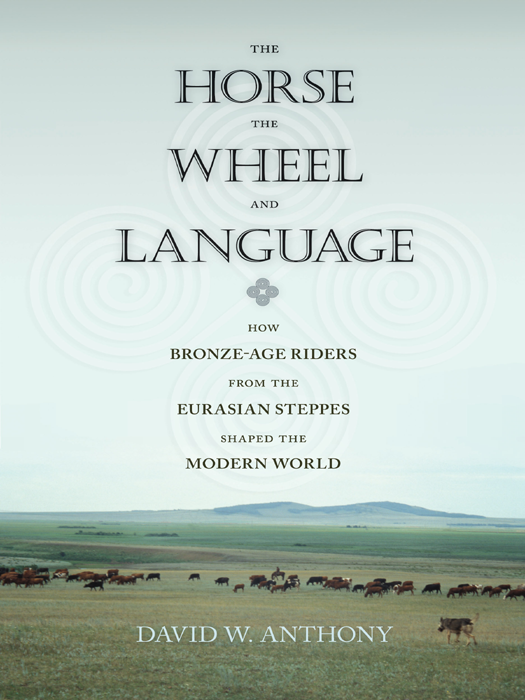
THE
HORSE
THE
WHEEL
AND
LANGUAGE

HOW
BRONZE-AGE RIDERS
FROM THE
EURASIAN STEPPES
SHAPED THE
MODERN WORLD
DAVID W. ANTHONY
Princeton University Press
Princeton and oxford
Copyright 2007 by Princeton University Press
Published by Princeton University Press, 41 William Street, Princeton, New Jersey 08540
In the United Kingdom: Princeton University Press, 3 Market Place, Woodstock,
Oxfordshire OX20 1SY
All Rights Reserved
ISBN-13: 978-0-691-05887-0
Library of Congress Control Number: 2007932082
British Library Cataloging-in-Publication Data is available
This book has been composed in Adobe Caslon
Printed on acid-free paper
press.princeton.edu
Printed in the United States of America
1 3 5 7 9 10 8 6 4 2

PART ONE
Language and Archaeology
Chapter One
The Promise and Politics of the Mother Tongue
Chapter Two
How to Reconstruct a Dead Language
Chapter Three
Language and Time 1:
The Last Speakers of Proto-Indo-European
The Size of the Chronological Window:
How Long Do Languages Last?
The Terminal Date for Proto-Indo-European:
The Mother Becomes Her Daughters
The Oldest and Strangest Daughter (or Cousin?):
Anatolian
Chapter Four
Language and Time 2:
Wool, Wheels, and Proto-Indo-European
Chapter Five
Language and Place:
The Location of the Proto-Indo-European Homeland
Chapter Six
The Archaeology of Language
PART TWO
The Opening of the Eurasian Steppes
Chapter Seven
How to Reconstruct a Dead Culture
Chapter Eight
First Farmers and Herders: The Pontic-Caspian Neolithic
Chapter Nine
Cows, Copper, and Chiefs
Chapter Ten
The Domestication of the Horse and the Origins of Riding: The Tale of the Teeth
Chapter Eleven
The End of Old Europe and the Rise of the Steppe
Warfare and Alliance:
The Cucuteni-Tripolye Culture and the Steppes
Chapter Twelve
Seeds of Change on the Steppe Borders: Maikop Chiefs and Tripolye Towns
Chapter Thirteen
Wagon Dwellers of the Steppe: The Speakers of Proto-Indo-European
Chapter Fourteen
The Western Indo-European Languages
Chapter Fifteen
Chariot Warriors of the Northern Steppes
Chapter Sixteen
The Opening of the Eurasian Steppes
Chapter Seventeen
Words and Deeds

This book would not have been written without the love and support of my mother and father, David F. and Laura B. Anthony. Laura B. Anthony read and commented on every chapter. Bernard Wailes drew me into the University of Pennsylvania, led me into my first archaeological excavation, and taught me to respect the facts of archaeology. I am blessed with Dorcas Brown as my partner, editor, critic, fellow archaeologist, field excavation co-director, lab director, illustrator, spouse, and best friend through thick and thin. She edited every chapter multiple times. All the maps and figures are by D. Brown. Much of the content in was the product of our joint research, published over many years. Dorcass brother, Dr. Ben Brown, also helped to read and edit the ms.
The bit-wear research described in from the State University of New York at Cobleskill. We are particularly grateful to the National Science Foundation (NSF).
Support to write this book was provided by a fellowship from the National Endowment for the Humanities in 19992000 and a membership in the School of Historical Studies at the Institute for Advanced Study (IAS) at Princeton, New Jersey, in 2006, where Nicola DiCosmo and Patricia Crone made us welcome. The term at the IAS was crucial.
People who have helped me in numerous different ways include:
Near East and East Asia: Kathy Linduff, Victor Mair, Oscar Muscarella, Karen Rubinson, Chris Thornton, Lauren Zych, C. C. Lamberg-Karlovsky, Fred Hiebert, Phil Kohl, Greg Possehl, Glenn Schwartz, David Owen, Mitchell Rothman, Emmy Bunker, Nicola DiCosmo, and Peter Golden.
Horses and wheeled vehicles: Dexter Perkins and Pat Daly; andor Bknyi, Sandra Olsen, Mary Littauer and Joost Crouwel (my instructors in ancient transport); and Peter Raulwing, Norbert Benecke, and Mindy Zeder.
Bit wear and the riding experiment: Mindy Zeder, Ron Keiper; the Bureau of Land Management, Winnemucca, Nevada; Cornell University Veterinary School; University of Pennsylvania New Bolton Center; the Assateague Island Wildlife Refuge; and, at the State University of New York at Cobleskill, Steve MacKenzie, Stephanie Skargensky, and Michelle Beyea.
Linguistics: Ward Goodenough, Edgar Polom, Richard Diebold, Winfrid Lehmann, Alexander Lubotsky, Don Ringe, Stefan Zimmer, and Eric Hamp. A special thanks to Johanna Nichols, who helped edit , and J. Bill Darden and Jim Mallory, who reviewed the first draft.
Eastern European archaeology: Petar Glumac (who made me believe I could read Russian-language sources), Peter Bogucki, Douglass Bailey (who reviewed ), Ruth Tringham (who gave me my first field experience in Eastern Europe), Victor Shnirelman (our first guide in Russia), Dimitri Telegin (my first source on steppe archaeology), Natalya Belan, Oleg Zhuravlev, Yuri Rassamakin, Mikhail Videiko, Igor Vasiliev, Pavel Kuznetsov, Oleg Mochalov, Aleksandr Khokhlov, Pavel Kosintsev, Elena Kuzmina, Sergei Korenevskii, Evgeni Chernykh, R. Munchaev, Nikolai Vinogradov, Victor Zaibert, Stanislav Grigoriev, Andrei Epimakhov, Valentin Dergachev, and Ludmila Koryakova. Of these I owe the deepest debts to Telegin (my first guide) and my colleagues in Samara: Vasiliev, Kuznetsov, Mochalov, Khokhlov, and (honorary Samaran) Kosintsev.
The errors I have made are mine alone; these people tried their best.


When you look in the mirror you see not just your face but a museum. Although your face, in one sense, is your own, it is composed of a collage of features you have inherited from your parents, grandparents, great-grandparents, and so on. The lips and eyes that either bother or please you are not yours alone but are also features of your ancestors, long dead perhaps as individuals but still very much alive as fragments in you. Even complex qualities such as your sense of balance, musical abilities, shyness in crowds, or susceptibility to sickness have been lived before. We carry the past around with us all the time, and not just in our bodies. It lives also in our customs, including the way we speak. The past is a set of invisible lenses we wear constantly, and through these we perceive the world and the world perceives us. We stand always on the shoulders of our ancestors, whether or not we look down to acknowledge them.
Font size:
Interval:
Bookmark:
Similar books «The Horse, the Wheel, and Language»
Look at similar books to The Horse, the Wheel, and Language. We have selected literature similar in name and meaning in the hope of providing readers with more options to find new, interesting, not yet read works.
Discussion, reviews of the book The Horse, the Wheel, and Language and just readers' own opinions. Leave your comments, write what you think about the work, its meaning or the main characters. Specify what exactly you liked and what you didn't like, and why you think so.

